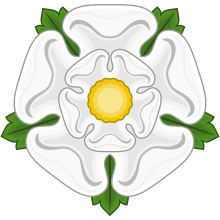York House
The House of York was an English royal family that fought with the House of Lancaster for the English crown in the second half of the 15th century . Both the Yorks and the Lancasters were branch lines of the English royal family Plantagenet (see also the family tree of the Houses Lancaster and York ). Towards the end, the differences led to the War of the Roses . This war is so named because both houses have roses in their arms, the Yorks a white and the Lancasters a red. Ancestral seat of the house was Fotheringhay Castle .
The founding of the House of York is dated to the year 1385, when Edmund of Langley , the fifth son of King Edward III. who created the title of Duke of York . Richard Plantagenet was a grandson of the first Duke of York and laid claim to the English throne, which was then Henry VI. held. Henry VI. was a descendant of John of Gaunt, 1st Duke of Lancaster , the fourth son of Edward III. and the head of the House of Lancaster. Richard Plantagenet justified his claims to the throne with the fact that he had an older and greater right to the English throne through his maternal grandfather, Roger Mortimer , because his son Edmund Mortimer had been recognized by Richard II as a presumed heir. When Edmund Mortimer died childless, the claim to his sister Anne Mortimer's son , Richard Plantagenet, was now transferred .
The amicable settlement of the two houses was approved by Parliament, because it saw the Duke of York's claim as justified, but did not want to overthrow the current king. So it was decided that on Henry's death the House of York should inherit the English throne, with which King Henry VI. agreed.
But not all of the Lancaster family agreed, especially Margaret of Anjou , the king's wife, who wanted the throne secured for her eldest son Edward of Westminster , the Prince of Wales. They raised an army in 1455 to enforce Edward's claim by force of arms, and the War of the Roses began. In 1460 Richard Plantagenet, 3rd Duke of York, was killed in the Battle of Wakefield . His eldest son was proclaimed King of England as Edward IV in 1461 . Edward IV was thus the first English king from the House of York.
Edward IV died in 1483 and his son, twelve-year-old Edward, ascended the throne as Edward V. But Richard Plantagenet, Duke of Gloucester , a paternal uncle, had Edward and his brother locked in the Tower of London (see Princes in the Tower ) and was named Richard III. crowned king on June 26, 1483, Edward V and his brother disappeared forever. Richard III but fell on August 22, 1485 in the Battle of Bosworth Field , the last battle of the War of the Roses. With his death, the York dynasty came to an end on the English throne. The Bosworth victor was Henry Tudor, Earl of Richmond, of the Lancaster family on his mother's side. As Henry VII he ascended the English throne in 1485 and, in addition to consolidating his power, married the daughter of Edward IV and heiress of the House of York, Elizabeth . He founded the House of Tudor on the English royal throne.
But even though the two houses were united, the disputes continued. In addition to Elizabeth's descendants, John de la Pole, Earl of Lincoln , also laid claim to the throne. Impostors like Perkin Warbeck also tried their luck to become King of England at this very confusing time. The last serious heir to the throne of the House of York was the son of the Duchess of Suffolk, Elizabeth of York , Richard de la Pole .
Kings of the House of York were:
- Edward IV , reigns 1461–1470 and 1471–1483
- Edward V , ruled alone in 1483 (he was one of the two princes in the Tower).
- Richard III , Reign 1483–1485
